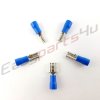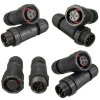Fuel Rail Connector. Having driven from the South of Spain...to the Isle of Skye via Amsterdam – for the ferry to Newcastle, the one and only problem I had with my Freelander 1, Td4, HSE 2006, 2.0 diesel was the Fuel Rail Connector breaking its connection. I used my IcarSoft Diagnostics scanner to determine where the problem lay, and it was correct. I wouldn't travel far without one of these marvelous units.

Having cleaned the plug’s connections, the car drove okay - for a while, until the fault happened again. After another clean, followed by a spray of WD40, it lasted for a very long time until it eventually played-up... again. That persuaded me to do something more permanent. And rather than buy another connector that might very well prove to be problematic, I went for something else.
I fabricated a cable; one that connected to the existing car’s wiring harness using an in-line plug and female spade crimps.
I bought the following items on Ebay for this project…

Blue Insulated Female Spade Terminals Crimps Electrical Wire Connectors 15A
Size 0.8mm x 2.8mm

IP68 3/4/5/6 Pins Assembled Waterproof Electrical Cable Connector Plug Socket YX

Then it was a case of cutting the existing plug off the harness and replacing it with my own.



All the joints are soldered and the in-line plug/socket has been given an extra seal using clear mastic over the soldered joints.
While soldering the car’s harness wires to the in-line connector I disconnected the ECU in its entirety. I didn’t want any possible charge (back EMF) from the soldering iron to reach its electronics.
Then it was simple case of connecting everything and ensuring it was all protected and safe.
The old plug? I’ve used it to make another cable, one that can be connected to the in-line connector. Just in case.

The cost of all this is less than €10 and I hope the fault does not rear its head again.
Having cleaned the plug’s connections, the car drove okay - for a while, until the fault happened again. After another clean, followed by a spray of WD40, it lasted for a very long time until it eventually played-up... again. That persuaded me to do something more permanent. And rather than buy another connector that might very well prove to be problematic, I went for something else.
I fabricated a cable; one that connected to the existing car’s wiring harness using an in-line plug and female spade crimps.
I bought the following items on Ebay for this project…

Blue Insulated Female Spade Terminals Crimps Electrical Wire Connectors 15A
Size 0.8mm x 2.8mm

IP68 3/4/5/6 Pins Assembled Waterproof Electrical Cable Connector Plug Socket YX

Then it was a case of cutting the existing plug off the harness and replacing it with my own.



All the joints are soldered and the in-line plug/socket has been given an extra seal using clear mastic over the soldered joints.
While soldering the car’s harness wires to the in-line connector I disconnected the ECU in its entirety. I didn’t want any possible charge (back EMF) from the soldering iron to reach its electronics.
Then it was simple case of connecting everything and ensuring it was all protected and safe.
The old plug? I’ve used it to make another cable, one that can be connected to the in-line connector. Just in case.

The cost of all this is less than €10 and I hope the fault does not rear its head again.
